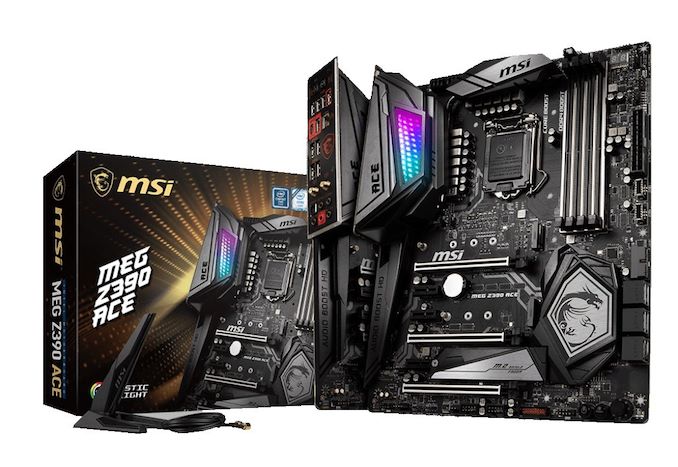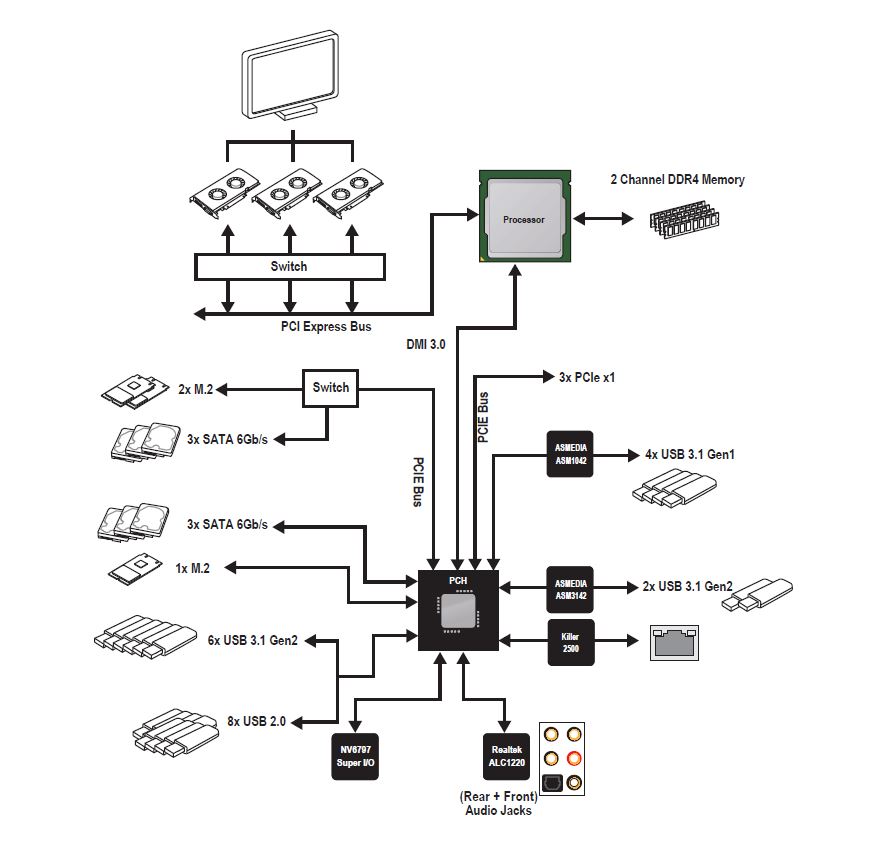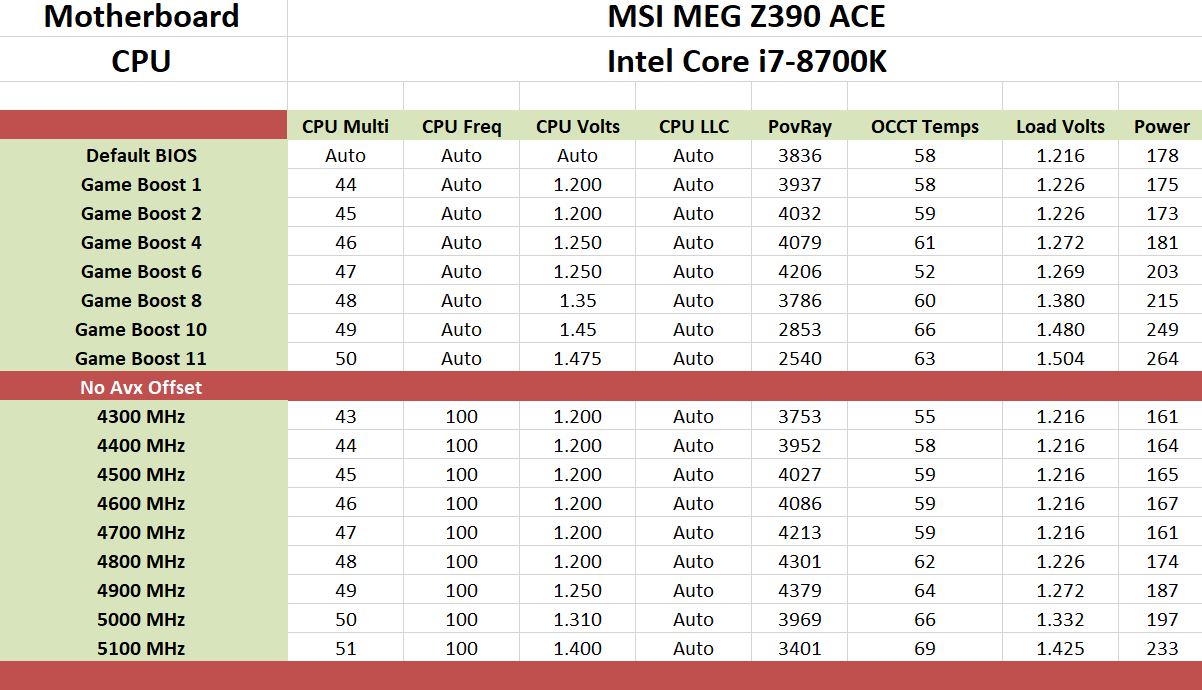The MSI MEG Z390 ACE Motherboard Review: The Answer To Your USB 3.1 Needs
by Gavin Bonshor on December 17, 2018 12:30 PM EST- Posted in
- Motherboards
- Intel
- Killer
- MSI
- Coffee Lake
- i7-8700K
- Z390
- ACE
- Z390 ACE

The MSI Z390 ACE sits below the MSI Z390 Godlike in the company's product stack and has plenty to shout about including a trio of M.2 slots, a well built power delivery, and as many USB 3.1 Gen 2 ports as you could ever need.
AnandTech 9th Gen CPU and Z390 Motherboard Coverage
- The Intel 9th Gen Review: Core i9-9900K, Core i7-9700K and Core i5-9600K Tested
- The ASRock Z390 Taichi Review: Jack of All Trades, Master of None
- Intel to Support 128GB of DDR4 on Core 9th Gen Desktop Processors
- Intel Z390 Motherboard Overview: 50+ Motherboards Analyzed
- GSkill Announces DDR4-4800 and DDR4-4500 Kits for Z390 Boards
The MSI MEG Z390 ACE Overview
The MSI Z390 ACE motherboard is aimed at gamers who are looking for premium features to create the foundations for a high-powered gaming system. In this case, MEG stands for 'MSI Enthusiast Gaming', which makes the first MSI redundant, and ACE doesn't stand for anything here, but MSI likes to make their brand names in ALL CAPS just like the GODLIKE so they pop out of the page when people scroll through the product list at Amazon or Newegg. Someone at MSI has put the marketing and naming into 'OVERDRIVE' (please don't make an all-caps motherboard called overdrive, please).
This model comes from MSI's premium product line, the Enthusiast Gaming range, and commands the weighty MSRP of $290. For that amount of money, MSI has to offer something special. The MSI Z390 ACE's core feature set includes four RAM slots with support for DDR4-4500 memory, three M.2 slots, six SATA ports, upgraded audio, a gaming focused 'Killer' network port, and the latest Intel Wi-Fi connectivity. On the design front, the Z390 ACE has a matte black PCB with a set of contrasting gunmetal grey heatsinks and a matching rear panel cover. The rear panel cover features an MSI Mystic Light Infinity panel which has a variety of customizable colors and effects which can be controlled by the MSI Mystic Light RGB software.
A quick glance at the specifications shows that the MSI Z390 ACE is a sub-set of the halo top-end MEG Z390 Godlike and is reflected in both the size and the in the price differences. The MSI Z390 ACE makes use of a Realtek ALC1220 HD audio codec and in keeping things consistent with a gaming flavor, MSI has also opted to use a Killer based E2500 Gigabit gaming LAN controller. In addition to this is the inclusion of an Intel 9560 802.11ac MU-MIMO Wave2 capable adapter which affords users both Wi-Fi and Bluetooth 5.0 connectivity.
Block diagram of the MSI Z390 ACE motherboard
On the technical front, MSI is advertising the Z390 ACE to contain a 13-phase power delivery. The heatsink attached itself has plenty of weight to it. The VCore/CPU section is running twelve ON Semiconductor high-side and low-side MOSFETs. This is controlled by an International Rectifier IR35201 PWM controller which is an 8-channel controller operating at 6+2. Each of the VCore phases features six individual doublers meaning the Z390 ACE is running a 6-phase design on the VCore. Providing power to the CPU is two 8-pin 12 V ATX power inputs while a standard 24-pin 12 V ATX input is there for to power the rest of the motherboards components.
With a total of three full-length PCIe 3.0 slots present, it is possible to run three-way CrossFire multi-graphics card setups on the Z390 ACE, but due to bandwidth limitations, a maximum of two NVIDIA cards in SLI can be accommodated. At the bottom right-hand of the PCB is an overclockers toolkit too. Cooling support is provided by seven 4-pin fan headers. USB 3.1 Gen2 ports are found on the rear panel, both Type-A and Type-C.
Looking at the performance of the MSI MEG Z390 ACE, nothing stands out as exemplary, although the most notable positives came in our 7-Zip encoding test and currently sits at the top of this benchmark. Another positive result came in our 3D Particle Movement and in POV-Ray, with comparable performance to other Z390 chipset boards on other tests. For system related tests such as POST time, the Z390 ACE sits middle of the road with a respectable time of just over 19 seconds; this was improved upon with controllers turned off in the BIOS by around 1 and a half seconds. Performance in other system-specific tests such as DPC Latency also sat middle of the road. The only real negative in our testing was in power consumption, which we explain in the review.
On the overclocking side of things, the MSI Z390 ACE performed well with manual overclocking, but ludicrous towards the upper end of the Game Boost profiles. As shown manually, we hit 5.0 GHz in our testing. There is plenty of headroom available for users looking to push their 8th and 9th generation processors beyond 5.0 GHz on this board, but the biggest factor in achieving this is keeping core temperatures as low as possible. Users with a 9900K might see better performance with the default solder-based thermal interface material.
The MSI Z390 ACE is one of two enthusiast specific MEG Z390 models which are aimed at the more premium end of the market. The other model in question is the MSI MEG Z390 Golike ($600) which sits right at the top of MSI's Z390 product stack for a sizable price. The Z390 ACE bridges the gap between the Z390 Godlike and the MPG Z390 Gaming Pro Carbon AC ($230) with a solid set of features. With a recommended retail price of $290, and the combination of specifications and aesthetics, MSI looks to woo users across multiple market areas.
Pages In This Review
- Overview [this page]
- Visual Inspection: Analysis of the Board Components
- BIOS and Software: Looking that the non-hardware portion
- Board Features and Test Bed: The full specification list, and how we test
- System Performance: Component testing, such as power, boot times, and DPC Latency
- CPU Performance
- Gaming Performance
- Conclusion














25 Comments
View All Comments
rsandru - Monday, December 17, 2018 - link
Well, that's the problem, I'm already on an HEDT platform but I'm missing on the the fastest CPUs for gaming in exchange of many PCI-E lanes and quad-channel memory that I don't need.I suppose I just can't have it all on the consumer platform for the time being...
CheapSushi - Monday, December 17, 2018 - link
Are you talking just about the cheapest platforms? Because it does exist already.oRAirwolf - Monday, December 17, 2018 - link
Stopped reading as soon as I saw the word "Killer."The_Assimilator - Monday, December 17, 2018 - link
Ditto; that trash does not belong on a board that costs nearly three hundred dollars.CheapSushi - Monday, December 17, 2018 - link
Why? Why are people still throwing out this old garbage of a viewpoint? They're just rebadged Qualcomm Atheros chips. The "Killer" part is just a software addon that makes it function like a router if you want. Do want router like function? Already have a dedicated router? Cool. Don't install the software. Are you saying Atheros are crap? There's nothing wrong with it. Everyone just says "Intel" because they're bog standard and had better support for Linux unlike Realtek but don't know much about it detail wise. Hell, other companies are doing better add-on chips now, especially past 1Gpbs, like Aquantia. But according to the mindshare....who cares right?PeachNCream - Tuesday, December 18, 2018 - link
For a desktop PC with a full ATX motherboard, the presence of a Killer network adapter is a problem that can be overcome by simply adding a cheap RealTek or whatever else in an expansion slot. Its almost a non-issue since you can just disable it and forget it exists. It becomes a more significant issue on a laptop where you may have motherboard integrated hardware and no alternative or a warranty that would discourage a surgical procedure to remove and replace the hardware in question.As for Rivet Networks, the issue there is the fact that the company is basically rebranding 3rd party hardware, adding worthless traffic prioritization software that while finally not entirely unstable still serves no useful purpose, and presenting it as a premium solution to the point that even journalists like those at Anandtech were, for a time, mindlessly touting them as a desirable feature despite having zero supporting evidence and not a single review for years. Even earlier than that, Killer NIC drivers were awful and thusly earned a well-deserved reputation as a pig wearing a lot of lipstick. People picking up Killer NICs in the post "my network adapter runs a Linux OS and has a freakish metal K heatsink on the SoC" era were under the impression they were getting superior hardware but actually ended up with a rebranded whatever that was festooned with iffy drivers and saddled with a dumpster fire attempt at filtering and prioritizing packets.
In the end, people are bitter. That historic distaste keeps getting reinforced by the number of times the brand has been spun off, bought, and sold. They got sick of being sold something that didn't work and are sick of seeing Killer hardware slung at them as premium or magically better without evidence to verify the software actually does anything more than eat CPU cycles for no reason. That breeds discontent and no small number of outspoken, fed up people that hope tech journalists will eventually get feedback up to OEMs like MSI so the company stops sticking buyers with Rivet's ethernet and wireless products because the companies don't understand the mindset of their potential customers. Its taken us years of railing in comments about Killer NICs to even get to the point where Anandtech doesn't tell us "It's got a primo-uber-tuber-you-have-to-love-it-Killer-NIC lol disclaimer no benchmarkz whatsoever hahaha!" when a product passes through here with Rivet's rebadged gear soldered on it. Its a good change when the Killer NIC just gets noted with a neutral comment on the opening page, but I think a lot of us are waiting with our sour grapes for the day when Rivet Networks goes out of business so we can happily buy a computer with literally any other network adapter in it.
Aikouka - Wednesday, December 19, 2018 - link
Honestly, I've been wary of them ever since I ran into a driver issue that caused some nasty memory leaks. That was a fun one to diagnose... "Hm, why is it that whenever I download anything, my memory usage shoots through the roof?" All I can say is that it's a good thing that I build my main machines with 32GB+ of memory!sharathc - Monday, December 17, 2018 - link
I hate to see Spectre/Meltdown this that shit patches in the OS row under Test Setup. Thanks Intel for your performance turned security risks features.sharathc - Monday, December 17, 2018 - link
I hate to see Spectre/Meltdown this that shit patches in the OS row under Test Setup. Thanks Intel for your performance turned security risks features.hapkiman - Tuesday, December 18, 2018 - link
I recently purchased this mobo, and I have to say I am very pleased with it and it looks great with the grey/gun metal color and RGB panel (really does look pretty cool). This is a very solid high quality board. You can just feel the "heft" and quality of it when making your build. I have typically been an ASUS fan over the years, but I am very happy with this MSI board. I'm currently getting a 5GHz OC on all 8 cores on my i9 9900K at 1.3v and no other settings changed. But I'm just starting to play with it. Thanks for the review.